Sony CPD-100ES, CPD-100EST, CPD-200ES, CPD-200EST User Manual

3-864-001-31 (1)
Trinitron Color
Computer Display
Operating Instructions |
EN |
|||||
|
|
|
|
|
|
|
Mode d’emploi |
|
F |
||||
|
|
|
|
|||
Bedienungsanleitung |
D |
|||||
|
|
|
|
|||
Manual de instrucciones |
|
ES |
||||
|
|
|
||||
Istruzioni per I'uso |
|
|
|
|
I |
|
CPD-100ES/100EST
CPD-200ES/200EST
© 1998 by Sony Corporation

Owner’s Record
The model and serial numbers are located at the rear of the unit. Record the serial number in the space provided below. Refer to these numbers whenever you call upon your dealer regarding this product.
Model No. |
|
Serial No. |
Hinweise
•AusergonomischenGründenwirdempfohlen,die Grundfarbe Blau nicht auf dunklem Untergrund zu verwenden(schlechteErkennbarkeit,Augenbelastungbeizu geringemZeichenkontrast).
•AusergonomischenGründenflimmernsolltennur DarstellungenbeiVertikalfrequenzenab70Hz(ohne Zeilensprung)benutztwerden.
WARNING
To prevent fire or shock hazard, do not expose the unit to rain or moisture. Dangerously high voltages are present inside the set. Do not open the cabinet. Refer servicing to qualified personnel only.
FCC Notice
This equipment has been tested and found to comply with the limits for a Class B digital device, pursuant to Part 15 of the FCC Rules. These limits are designed to provide reasonable protection against harmful interference in a residential installation. This equipment generates, uses, and can radiate radio frequency energy and, if not installed and used in accordance with the instructions, may cause harmful interference to radio communications. However, there is no guarantee that interference will not occur in a particular installation. If this equipment does cause harmful interference to radio or television reception, which can be determined by turning the equipment off and on, the user is encouraged to try to correct the interference by one or more of the following measures:
–Reorient or relocate the receiving antenna.
–Increase the separation between the equipment and receiver.
–Connect the equipment into an outlet on a circuit different from that to which the receiver is connected.
–Consult the dealer or an experienced radio/TV technician for help. You are cautioned that any changes or modifications not expressly approved in this manual could void your authority to operate this equipment.
INFORMATION
This product complies with Swedish National Council for Metrology (MPR) standards issued in December 1990 (MPR II) for very low frequency (VLF) and extremely low frequency (ELF).
INFORMATION
Ce produit est conforme aux normes du Swedish National Council for Metrology de décembre 1990 (MPR II) en ce qui concerne les fréquences très basses (VLF) et extrêmement basses (ELF).
Hinweis
Dieses Gerät erfüllt bezüglich tieffrequenter (very low frequency) und tiefstfrequenter (extremely low frequency) Strahlung die Vorschriften des „Swedish National Council for Metrology (MPR)“ vom Dezember 1990 (MPR II).
INFORMACIÓN
Este producto cumple las normas del Consejo Nacional Sueco para Metrología (MPR) emitidas en diciembre de 1990 (MPR II) para frecuencias muy bajas (VLF) y frecuencias extremadamente bajas (ELF).
Dieses Gerät entspricht den folgenden europäischen EMVVorschriften für Betrieb in Wohngebieten, gewerblichen Gebieten und Leichtindustriegebieten.
EN55022/1994 Klasse B
EN50082-1/1992
EN60555-2/1987
NOTICE
ThisnoticeisapplicableforUSA/Canadaonly.
If shipped to USA/Canada, install only a UL LISTED/CSA LABELLEDpowersupplycordmeetingthefollowing specifications:
SPECIFICATIONS
PlugType |
Nema-Plug5-15p |
Cord |
Type SVT or SJT, minimum 3 × 18 |
|
AWG |
Length |
Maximum 15 feet |
Rating |
Minimum 7 A, 125 V |
NOTICE
Cettenotices’appliqueauxEtats-UnisetauCanada uniquement.
Si cet appareil est exporté aux Etats-Unis ou au Canada, utiliser le cordon d’alimentation portant la mention UL LISTED/CSA LABELLED et remplissant les conditions suivantes: SPECIFICATIONS
Typedefiche |
FicheNema5-15broches |
|||||||
Cordon |
Type SVT ou SJT, minimum 3 × 18 |
|||||||
|
|
|
|
|
AWG |
|||
Longueur |
Maximum15pieds |
|||||||
Tension |
Minimum 7 A, 125 V |
|||||||
|
|
|
|
|
|
|
|
|
|
|
|
|
|
|
|
|
|
|
|
|
|
|
|
|
|
|
|
|
|
|
|
|
|
|
|
For CPD-100EST/200EST only
This monitor complies with the
TCO’95 guidelines.
As an ENERGY STAR Partner, Sony Corporationhasdeterminedthatthis productmeetsthe ENERGY STAR guidelinesforenergyefficiency.
2
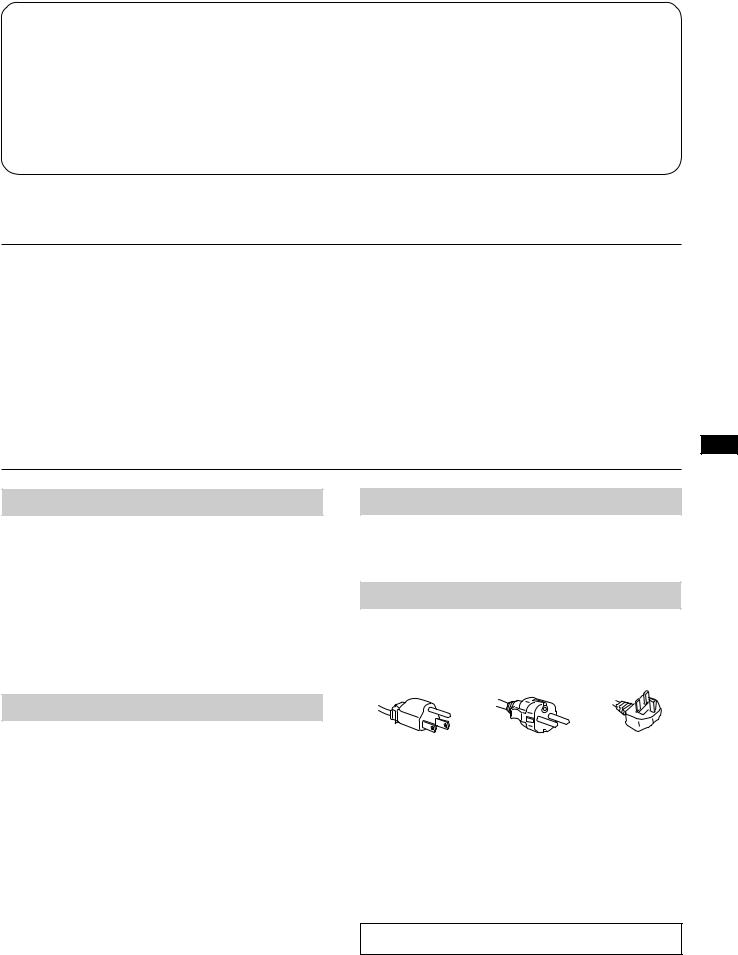
Table of Contents
Introduction .............................................................................. |
3 |
Power Saving Function |
........................................................... 8 |
Precautions ............................................................................... |
3 |
Plug and Play ........................................................................... |
8 |
Getting Started ......................................................................... |
4 |
Use of the Tilt-Swivel .............................................................. |
8 |
Using Your Monitor ................................................................ |
4 |
Damper Wire ............................................................................ |
8 |
Adjustments .............................................................................. |
5 |
Specifications ............................................................................ |
9 |
Entering New Timings............................................................ |
8 |
Troubleshooting ..................................................................... |
10 |
|
|
TCO’95 Eco-document .......................................................... |
43 |
Introduction
Congratulations on your purchase of a Sony Multiscan 100ES/200ES!
This monitor incorporates over 25 years of Sony experience with Trinitron display technology, ensuring excellent performance and outstanding reliability. The Multiscan 100ES/200ES’s wide scan range (30 – 70 kHz), together with Digital Multiscan Technology, allows it to sync to any video mode from standard VGA through VESA 1024 × 768 at 85 Hz.
In addition, its two factory preset color modes and one user adjustable color mode give you unprecedented flexibility in matching on-screen colors to hard copy printouts.
Furthermore, the Multiscan 100ES/200ES feature digital controls, raster rotation, power saving, low emissions, and much more. All together, it delivers incredible performance with the quality and support you can expect from Sony.
Precautions
EN
Installation
•Prevent internal heat build-up by allowing adequate air circulation. Do not place the unit on surfaces (rugs, blankets, etc.) or near materials (curtains, draperies) that may block the ventilation holes.
•Do not install the unit near heat sources such as radiators or air ducts, nor in a place subject to direct sunlight, excessive dust, mechanical vibration or shock.
•Do not place the unit near equipment which generates magnetism, such as a converter or high voltage power lines.
Transportation
When you transport this monitor for repairing or shipping, use the original carton box and packing materials.
Warning on Power Connection
•Use the supplied power cord.
For the customers in U.S.A.
If you do not do this, this monitor will not conform to mandatory FCC standards.
Maintenance
•Clean the cabinet, glass panel and controls with a soft cloth lightly moistened with a mild detergent solution. Do not use any type of abrasive pad, scouring powder or solvent, such as alcohol or benzine.
•Do not rub, touch, or tap the surface of the screen with sharp or abrasive items, like a ball point pen or a screw driver. This type of contact may result in a scratched picture tube.
•Clean the screen with a soft cloth. If you use a glass cleaning liquid, do not use any type of cleaner containing an anti-static solution or similar additive as this may scratch the screen's coating.
for 100 to 120 V AC for 220 to 240 V AC for 240 V only
•Before disconnecting the power cord, wait for at least
30 seconds after turning off the power switch to allow for the discharging of static electricity on the CRT display surface.
•After the power has been turned on, the CRT is demagnetized for approximately 5 seconds. This generates a strong magnetic field around the bezel which may affect the data stored on magnetic tape or disks near the bezel. Place such magnetic recording equipment and tapes/disks at a distance from this unit.
The socket-outlet shall be installed near the equipment and shall be easily accessible.
3
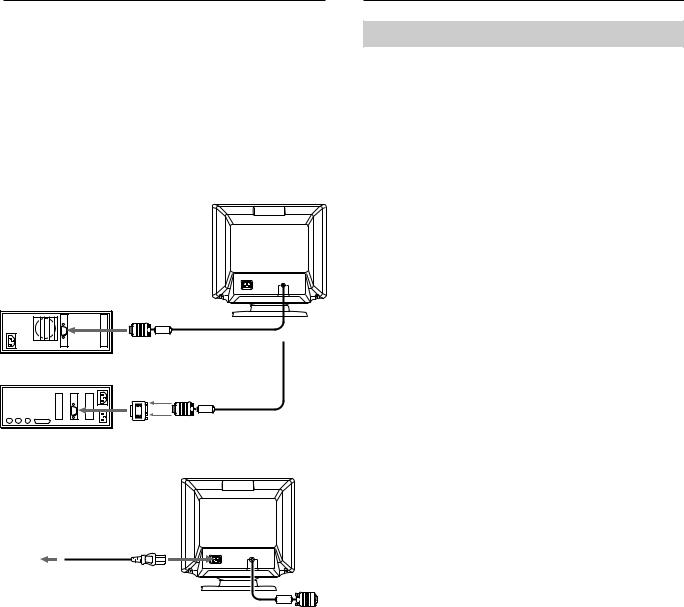
Getting Started
Before using this monitor, please make sure that the following items are included in your package: Multiscan 100ES/200ES monitor (1), power cord (1), “Windows Monitor Information Disk” (1), and this operating instruction manual (1).
This monitor will sync with any IBM or compatible system equipped with VGA or greater graphics capability. Although this monitor will sync to other platforms running at horizontal frequencies between 30 and 70 kHz, including Macintosh and Power Macintosh system, a cable adapter is required. Please consult your dealer for advice on which adapter is suitable for your needs.
Step 1: With the computer switched off, attach the video signal cable to the video output.
IBM or compatible computer
to video output
Macintosh or compatible computer
to video output
Macintosh adapter (not supplied)
Step 2: Attach the power cord to the monitor and the other end to a power outlet.
Power cord (supplied)
to a power outlet
Step 3: Turn on the monitor and computer.
Step 4: If necessary, adjust the user controls according to your personal preference.
The installation of your Multiscan 100ES/200ES is complete. Enjoy your monitor.
1)VGA is a trademark of IBM Corporation.
2)VESA is a trademark of the non-profit organization, Video Electronics Standard Association.
3)Macintosh is a trademark of Apple Computer Inc.
4)Windows® is a registered trademark of Microsoft Corporation in the United States and other countries.
Using Your Monitor
Preset and User Modes
The Multiscan 100ES/200ES has factory preset modes for the 8 most popular industry standards for true “plug and play” capability. For less common modes, the Multiscan 100ES/200ES’s Digital Multiscan Technology will perform all of the complex adjustments necessary to ensure a high quality picture for any timing between 30 and 70 kHz.
CPD-100ES/100EST and CPD-200ES/200EST
No. |
Resolution |
Horizontal |
Vertical |
Graphics |
|
(dots × lines) |
Frequency |
Frequency |
Mode |
|
|
|
|
|
1 |
640 × 480 |
31.5 kHz |
60 Hz |
VGA 1) Graphic |
2 |
640 × 480 |
43.3 kHz |
85 Hz |
VESA 2) |
3 |
800 × 600 |
46.9 kHz |
75 Hz |
VESA 2) |
4 |
800 × 600 |
53.7 kHz |
85 Hz |
VESA 2) |
5 |
832 × 624 |
49.7 kHz |
75 Hz |
Macintosh 3) |
|
|
|
|
16" Color |
|
|
|
|
|
6 |
1024 × 768 |
60.0 kHz |
75 Hz |
VESA 2) |
7 |
1024 × 768 |
68.7 kHz |
85 Hz |
VESA 2) |
8 |
1280 × 1024 |
64.0 kHz |
60 Hz |
VESA 2) |
For customers using Windows 4)95/98
To maximize the potential of your monitor, install the new model information file from the supplied Windows Monitor Information Disk onto your PC.
This monitor complies with the “VESA DDC” Plug & Play standard. If your PC/graphics board complies with DDC, select “Plug & Play Monitor (VESA DDC)” or this monitor’s model name as the monitor type in the “Control Panel” of Windows 95/98. If your PC/graphics board has difficulty communicating with this monitor, load the Windows Monitor Information Disk and select this monitor’s model name as the monitor type.
Recommended horizontal timing conditions
Horizontal sync width should be: >1.0 sec.
Horizontal blanking width should be: >3.6 sec. (Multiscan 100ES)/
>3.0 sec. (Multiscan 200ES). Vertical sync width should be: < 560 sec.
Note
CPD-100ES/100EST and CPD-200ES/200EST does not apply to Macintosh 21" color mode.
4
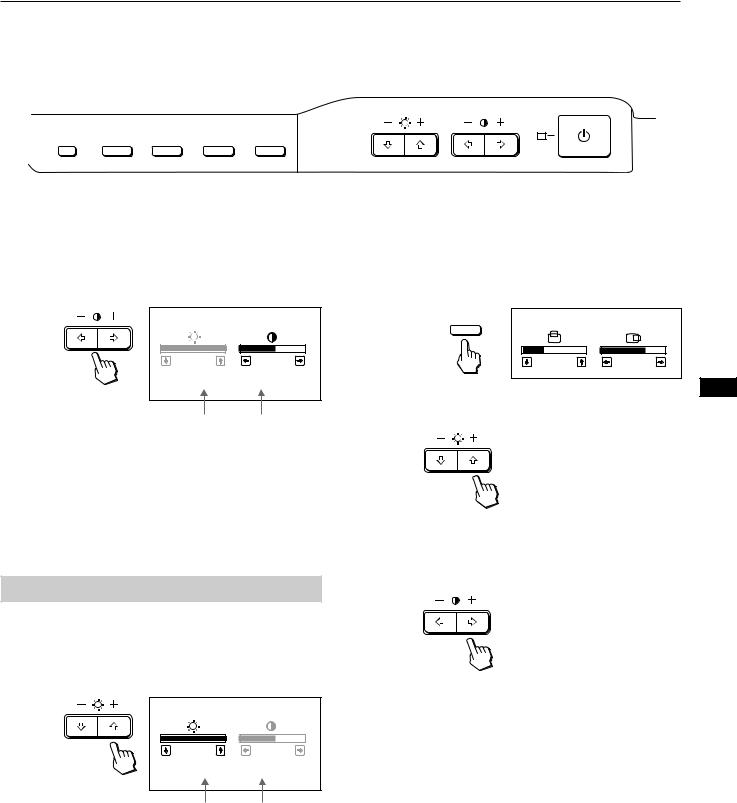
Adjustments
When one of the preset-type signals is input, no picture adjustment is necessary.
You can, however, adjust the picture to your preferences by following the procedure described below.
You can adjust all items on the OSD (On Screen Display).
pBefore adjusting the items, turn on the unit and feed the video signal from the connected computer/work station.
pAdjustments will be stored automatically.
Control Panel
RESET COLOR GEOM SIZE CENTER
Adjusting the Picture Contrast |
|
Adjusting the Picture Centering |
The adjustment data becomes the common setting for all input signals.
1 Press the >?//button.
The “BRIGHTNESS/CONTRAST” OSD appears.
The adjustment data becomes the individual setting for each input signal received.
1 Press the CENTER button. The “CENTER” OSD appears.
BRIGHTNESS/CONTRAST |
|
100 |
50 |
31 . 5kHz/70Hz |
|
|
2 |
Horizontal |
Vertical |
frequency |
frequency |
CENTER |
CENTER |
|
|
32 |
68 |
EN
For vertical adjustment
Press the ¨>/.buttons.
2 Press the >?//buttons to adjust picture contrast. /. . . for more contrast
?. . . for less contrast
The “BRIGHTNESS/CONTRAST” OSD disappears approximately 3 seconds after you release the buttons.
To reset, press the RESET button while the OSD is on.
Adjusting the Picture Brightness
The adjustment data becomes the common setting for all input signals.
1 Press the ¨>/.button.
The “BRIGHTNESS/CONTRAST” OSD appears.
BRIGHTNESS/CONTRAST |
|
100 |
50 |
31 . 5kHz/70Hz |
|
>. . . to move up
.. . . to move down
For horizontal adjustment
Press the >?//buttons.
?. . . to move left /. . . to move right
To erase the “CENTER” OSD, press the CENTER button again.
The “CENTER” OSD automatically disappears 10 seconds after you release the buttons.
To reset, press the RESET button while the OSD is on.
Horizontal Vertical frequency frequency
2 Press the ¨>/.buttons to adjust picture brightness.
.. . . for less brightness >. . . for more brightness
The “BRIGHTNESS/CONTRAST” OSD disappears approximately 3 seconds after you release the buttons.
The horizontal and vertical frequencies for each input signal received appear on the “BRIGHTNESS/CONTRAST” OSD.
To reset, press the RESET button while the OSD is on.
5
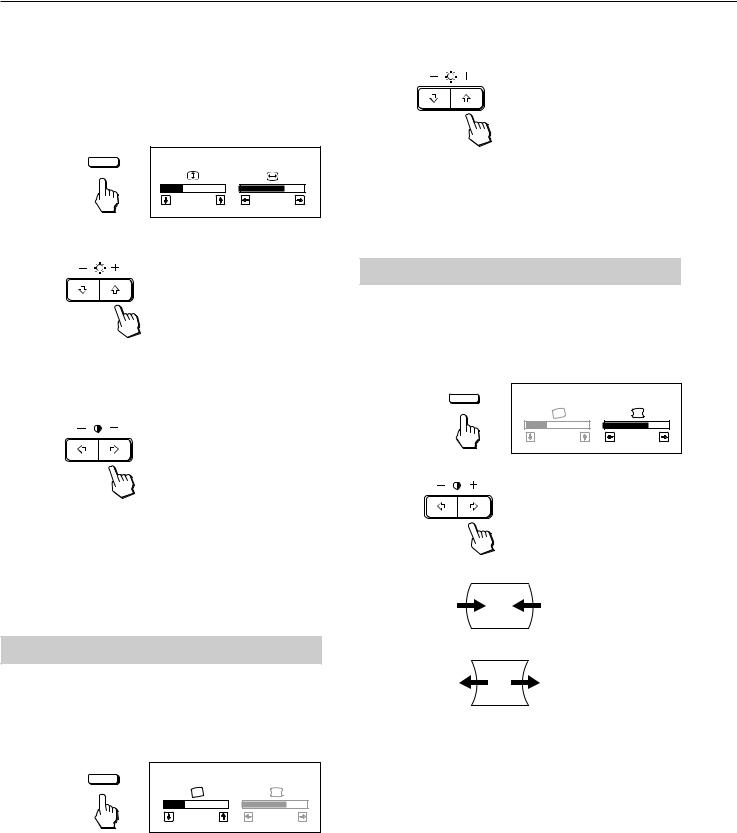
Adjustments
|
2 Press the ¨>/.buttons. |
|
Adjusting the Picture Size |
||
>. . . to rotate clockwise |
.. . . to rotate counter clockwise
The adjustment data becomes the individual setting for each input signal received.
1 Press the SIZE button. The “SIZE” OSD appears.
SIZE |
|
|
SIZE |
32 |
68 |
2 For vertical adjustment
Press the ¨>/.buttons.
To erase the “GEOMETRY” OSD, press the GEOM button again.
The “GEOMETRY” OSD automatically disappears 10 seconds after you release the buttons.
To reset, press the RESET button while the OSD is on.
>. . . to enlarge
.. . . to diminish
For horizontal adjustment
Press the >?//buttons.
?. . . to diminish /. . . to enlarge
To erase the “SIZE” OSD, press the SIZE button again. The “SIZE” OSD automatically disappears 10 seconds after you release the buttons.
To reset, press the RESET button while the OSD is on.
Adjusting the Picture Rotation
Adjusting the Pincushion
The adjustment data becomes the individual setting for each input signal received.
1 Press the GEOM button.
The “GEOMETRY” OSD appears.
GEOM |
|
GEOMETRY |
|
32 |
68 |
2 Press the >?//buttons. |
|
?. . . to diminish the picture sides
/. . . to expand the picture sides
The adjustment data becomes the common setting for all input signals.
1 Press the GEOM button.
The “GEOMETRY” OSD appears.
GEOM |
|
GEOMETRY |
|
32 |
68 |
To erase the “GEOMETRY” OSD, press the GEOM button again.
The “GEOMETRY” OSD automatically disappears 10 seconds after you release the buttons.
To reset, press the RESET button while the OSD is on.
6
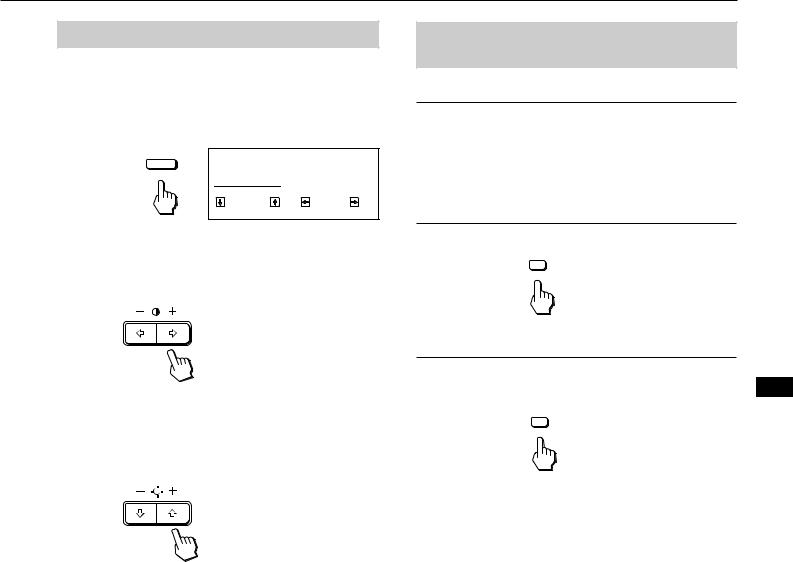
Setting the Color Temperature
The selected color temperature becomes the common setting for all input signals.
1 Press the COLOR button.
The “COLOR TEMPERATURE” OSD appears.
COLOR
COLOR TEMPERATURE VAR I ABLE


 5000K 9300K 50
5000K 9300K 50
2 Adjust with the > ?//and ¨ >/.buttons.
To select 5000K or 9300K
Press the > ?//buttons.
The selected color temperature is indicated in yellow.
?. . . to select 5000K /. . . to select 9300K
To obtain the desired color temperature between 5000K and 9300K
Press the ¨ >/.buttons.
>. . . for higher temperature
.. . . for lower temperature
Your most recent adjusted color temperature will be recalled by pressing the ¨ >/.button.
To erase the “COLOR TEMPERATURE” OSD, press the COLOR button again.
The “COLOR TEMPERATURE” OSD automatically disappears 10 seconds after you release the buttons.
To reset, press the RESET button while the OSD is on.
Resetting the Adjustment Data to Factory-preset Levels
To reset an adjustment item
Press the button of the adjustment item you want to reset, and then press the RESET button before the OSD (On Screen Display) disappears.
To reset all adjustment data at once (for the received signal)
Press the RESET button when no OSD is shown.
RESET
To reset all adjustment data to factorypreset levels
Press and hold the RESET button for more than 2 seconds. |
EN |
All adjustment data are reset to factory-preset levels. |
RESET
Note
If you have difficulties pressing the reset button, please use a pointed object (e.g. a pen).
7
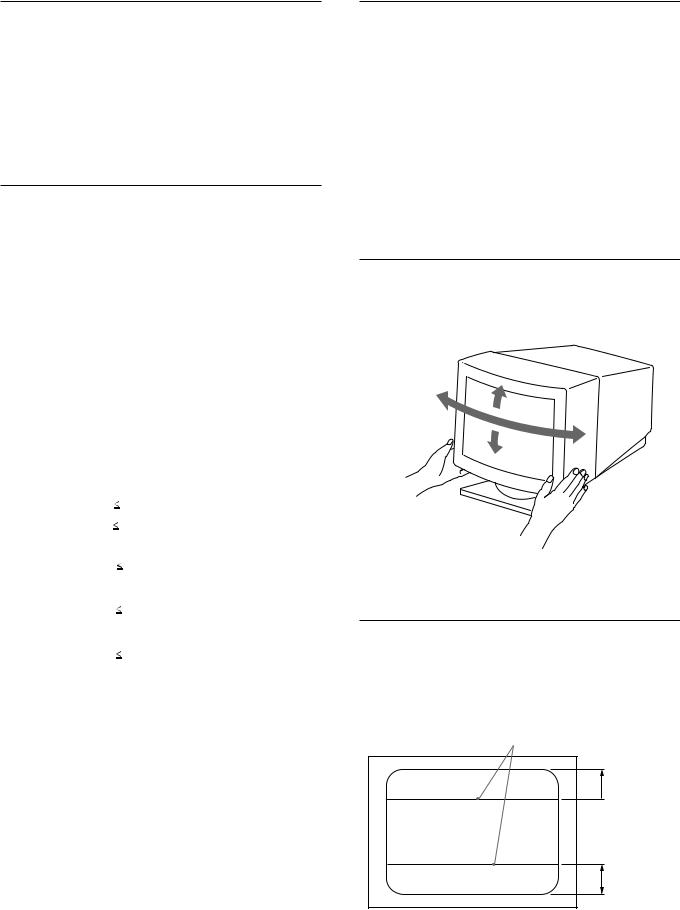
Entering New Timings
When using a video mode that is not one of the factory preset modes, some fine tuning may be required to optimize the display to your preferences. Simply adjust the monitor according to the preceding adjustment instructions. The adjustments will be stored automatically and recalled whenever that mode is used.
Power Saving Function
This monitor meets the power saving guidelines set by the International ENERGY STAR Program as well as the more stringent NUTEK guidelines. It is capable of reduced power consumption when used with a computer equipped with Display Power Management Signaling (DPMS). By sensing the absence of the sync signal coming from the computer, it will reduce the power consumption as follows:
CAUTION: The Power Saving function will automatically put the monitor into Active-off state if the power switch is turned on without any video signal input. Once the horizontal and vertical syncs are sensed, the monitor will automatically return to its Normal operation state.
|
State |
Power |
Recovery |
uPOWER |
|
|
consumption |
time |
indicator |
||
|
|
||||
|
|
|
|
|
|
|
Normal |
110 W |
|
|
|
1 |
(100ES/100EST) |
–– |
green on |
||
operation |
120 W |
||||
|
|
|
|||
|
|
(200ES/200EST) |
|
|
|
|
Standby |
|
approx. |
Orange and |
|
2 |
(1st step of |
15 W |
green flashes |
||
3 sec. |
|||||
|
power saving) |
|
alternately |
||
|
|
|
|
||
|
|
|
|
|
|
3 |
Suspend |
15 W |
approx. |
Orange and |
|
(2nd step of |
3 sec. |
green flashes |
|||
|
power saving) |
|
alternately |
||
|
|
|
|||
|
|
|
|
|
|
|
Active-off |
|
approx. |
Orange on |
|
4 |
(3rd step of |
8 W |
|||
10 sec. |
|||||
|
power saving) |
|
|
||
|
|
|
|
||
|
|
|
|
|
|
5 |
Power-off |
≈ 0 W |
–– |
off |
Plug and Play
This monitor complies with DDCTM1 and DDC2B, which are the Display Data Channel (DDC) standards of VESA. When a DDC1 host system is connected, the monitor synchronizes with the V. CLK in accordance with the VESA standards and outputs the EDID (Extended Display Identification Data) to the data line.
When a DDC2B host system is connected, the monitor automatically switches to the DDC2B communication.
DDCTM is a trademark of the Video Electronics Standard Association.
Use of the Tilt-Swivel
With the tilt-swivel, this unit can be adjusted to be viewed at your desired angle within 180˚ horizontally and 20˚ vertically. To turn the unit vertically and horizontally, hold it at its bottom with both hands.
15°
90°
90°
5°
Damper Wire
Using a white background, very thin horizontal stripes on the screen are visible as shown on the illustration. These stripes are damper wires. These wires are attached to the aperture grille inside the Trinitron tube and are there to dampen vibrations of the aperture grille in order to prevent them from influencing the picture quality.
Damper wire
Approx. 6 cm (CPD-200ES/  200EST only)
200EST only)
Approx. 6 cm
8

Specifications
CPD-100ES/100EST
Picture tube |
0.25 mm aperture grille pitch |
|
15 inches measured diagonally |
|
90 degree deflection |
Viewable image size Approx. 285 × 214 mm (w/h) (11 1/4 × 8 1/2 inches)
14.0” viewing image
Logical resolution |
Horizontal: Max. 1280 dots |
|
Vertical: Max. 1024 lines |
Physical resolution |
Horizontal: Max. 1024 dots |
|
Vertical: Max. 768 lines |
Standard image area Approx. 270 × 202 mm (w/h) (10 3/4 × 8 inches)
Deflection frequency Horizontal: 30 to 70 kHz Vertical: 50 to 120 Hz
AC input voltage/current
100 to 240 V, 50 – 60 Hz, 2 – 1 A
Dimensions |
Approx. 368 × 392 × 389 mm (w/h/d) |
|
(14 1/2 × 15 1/2 × 15 3/8 inches) |
Mass |
Approx. 14 kg (30 lb 14 oz) |
CPD-200ES/200EST |
|
|
|
Picture tube |
0.25 mm aperture grille pitch |
|
17 inches measured diagonally |
|
90 degree deflection |
Viewable image size Approx. 327 × 243 mm (w/h) (12 7/8 × 9 5/8 inches)
16.0” viewing image
Logical resolution |
Horizontal: Max. 1280 dots |
|
Vertical: Max. 1024 lines |
Physical resolution |
Horizontal: Max. 1280 dots |
|
Vertical: Max. 1024 lines |
Standard image area Approx. 312 × 234 mm (w/h) (12 9/32 × 9 7/32 inches)
Deflection frequency Horizontal: 30 to 70 kHz Vertical: 50 to 120 Hz
AC input voltage/current
100 to 240 V, 50 – 60 Hz, 2 – 1 A
Dimensions |
Approx. 406 × 431.5 × 420 mm (w/h/d) |
|
(16 × 17 × 16 5/8 inches) |
Pin assignment
Video signal cable (HD15) (Male)
The cable accepts RGB video signals (0.7 Vp-p, positive), and SYNC signals.
1 |
2 |
3 |
4 |
5 |
6 |
7 |
8 |
9 |
10 |
11 12 13 |
14 15 |
|||
Pin No. |
Signal |
Pin No. |
Signal |
|
|
|
1 |
Red |
8 |
Blue Ground |
|
|
|
2 |
Green |
9 |
— |
|
|
|
|
(Composite |
|
|
|
|
|
|
10 |
Ground |
|
|
||
|
Sync on Green) |
|
|
|||
|
|
|
|
|
||
|
11 |
Ground |
|
|
||
|
|
|
|
|||
3 |
Blue |
|
|
|
|
|
12 |
Bi-Directional |
|
|
|||
4 |
Ground |
|
Data (SDA) |
|
|
|
5 |
Ground |
13 |
H. Sync |
|
|
|
6 |
Red Ground |
14 |
V. Sync |
|
|
|
EN |
||||||
7 |
Green Ground |
15 |
Data Clock (SCL) |
|
||
|
|
As defined by Display Data Channel (DDC) Standard by VESA.
Note
Design and specifications are subject to change without notice.
Mass |
Approx. 18.5 kg (40 lb 13 oz) |
9

Troubleshooting
This section may help you isolate a problem and as a result, eliminate the need to contact technical support, allowing continued productivity.
No picture
/If the u POWER indicator is not lit.
—Check that the power cord is properly connected.
—Check that the uPOWER switch is in the “ON” position.
/If the u POWER indicator is flashing in green and orange alternately.
—Check that your computer power switch is in the “ON” position.
—The monitor will recover when you press any key on the keyboard of the computer.
—Check that the video cable is properly connected.
—Ensure that no pins are bent or pushed in the HD15 connector of the cable.
—Check that the video card is seated completely in a proper bus slot.
—Check that the video sync signal is within that specified for the monitor.
—If using a Macintosh system, check that a proper HD15 - D15 adapter is provided to work correctly with your Macintosh.
—The monitor has a self-diagnose function. After disconnecting the video signal cable from the computer, turn on the u POWER switch of the monitor. Press and hold the "+" side of the > button for 2 seconds, then color bars will appear. The monitor is operating normally if the red, green, and blue color bars appear. Contact the maker of the computer to which the monitor is connected.
/If the uPOWER indicator is flashing.
—There is a potential monitor failure. Contact your dealer.
If the message of “OUT OF SCAN RANGE” appears on the screen
/Check that the video sync signal is specified for the monitor.
Picture is scrambled
/Check your graphics board manual for the proper monitor setting on your Multiscan 100ES/200ES.
/Check this manual and confirm that the graphic mode and the frequency at which you are trying to operate is supported. Even within the proper range some video boards may have a sync pulse that is too narrow for the monitor to sync correctly.
Color is not uniform
/If the monitor is close to any potential sources of magnetic fields such as a speaker, or you turn the monitor while the u POWER switch is in the “ON” position, color may not be uniform. Trip the u POWER switch once to activate the Autodegauss cycle*.
Picture is flickering
/If the refresh rate is not appropriate, the picture may flicker. Set the refresh rate of the non-interlace mode as high as possible on the computer. For details on how to set the refresh rate, consult the dealer of your computer or video board.
Screen image is not centered or sized properly
/Adjust the “CENTER,” “SIZE,” or “GEOMETRY” on the OSD (pages 5, 6).
/Some video modes do not fill the screen to the edge of the monitor. There is no single answer to solve the problem. There is a tendency to have this problem on higher refresh timings and Macintosh video timings.
Picture is fuzzy
/Adjust the “CONTRAST” and “BRIGHTNESS” on the OSD (page 5). There are several brands of SVGA boards that have an excessive video output level which creates a fuzzy picture at maximum contrast.
/Trip the u POWER switch once to activate the Auto-degauss cycle .
Picture bounces or has wavy oscillations
/Isolate and eliminate any potential sources of electric or magnetic fields. Common causes for this symptom are electric fans, fluorescent lighting, laser printers, and so on.
/If you have another monitor close to this monitor, increase the distance between them to reduce the interference.
/Try plugging the monitor into a different AC outlet, preferably on a different circuit.
/Try the monitor on a completely different computer in a different room.
Picture appears to be ghosting
/Eliminate the use of video cable extension cables and/or video switch boxes if this symptom occurs. Excessive cable length or weak connections can produce this symptom.
A fine horizontal line (wire) is visible
/This is called a Damper wire, which stabilizes the vertically striped Aperture Grille (page 8). This Aperture Grille allows more light to pass through to the screen giving the Trinitron CRT more color and brightness.
Wavy or elliptical (moire) pattern is visible
/Due to the relationship between resolution, monitor Aperture Grille pitch and the pitch of some image patterns, certain screen backgrounds, especially gray, sometimes show moire. This can only be eliminated by changing your desktop pattern.
Just after turning the monitor on, a “boon” noise is heard
/Just after turning the monitor on, a noise may be heard for about 3 seconds.
This noise is not failure, it is caused by the Autodegauss cycle .
The Auto-degauss function demagnetizes the metal frame of the CRT to obtain a neutral field for uniform color reproduction. If a second degauss cycle is needed, allow a minimum interval of 20 minutes for the best result.
•If the problem persists, call your authorized Sony dealer from a location near your monitor.
•Note the model name and the serial number of your monitor. Also note the make and name of your computer and video board.
10

Table des matières
Introduction ............................................................................ |
11 |
Précautions ............................................................................. |
11 |
Préparation ............................................................................. |
12 |
Utilisation de votre moniteur .............................................. |
12 |
Réglages................................................................................... |
13 |
Introduction de nouvelles synchronisations..................... |
16 |
Economie d’énergie ............................................................... |
16 |
Un moniteur prêt à l’emploi (“Plug & Play”) ................... |
16 |
Utilisation du support pivotant .......................................... |
16 |
Fil d’amortissement ............................................................... |
16 |
Spécifications .......................................................................... |
17 |
Dépannage .............................................................................. |
18 |
TCO’95 Eco-document .......................................................... |
43 |
Introduction
Nous vous félicitons d’avoir fait l’acquisition d’un Sony Multiscan 100ES/200ES!
Ce moniteur intègre les plus de 25 années d’expérience de Sony dans la technologie d’affichage Trinitron, qui vous garantit d’excellentes performances et une fiabilité exceptionnelle. La vaste plage de balayage du Multiscan 100ES/200ES (30 – 70 kHz), ainsi que sa technologie numérique Multiscan, lui permettent de se synchroniser sur n’importe quel mode vidéo, du VGA standard au VESA 1024 × 768 à 85 Hz.
De plus, avec deux modes de couleur par défaut et un mode de couleur réglable par l’utilisateur, il assure une flexibilité inégalée en matière de correspondance des couleurs d’affichage et d’impression. Par ailleurs, le Multiscan100ES/ 200ES est doté de commandes numériques, d’une rotation de trame, d’une fonction d’économie d’énergie, d’un faible niveau d’émissions, etc. Bref, il allie des performances exceptionnelles à la qualité et à la fiabilité que vous êtes en droit d’attendre d’un Sony.
Précautions
F
Installation |
|
Transport |
|
|
|
•Veillez à assurer une circulation d’air adéquate pour éviter une surchauffe interne de l’appareil. Ne placez pas l’appareil sur des surfaces textiles (tapis, couvertures, etc.) ni à proximité de rideaux ou de draperies susceptibles d’obstruer les orifices de ventilation.
•N’installez pas l’appareil à proximité de sources de chaleur telles qu’un radiateur ou une conduite d’air chaud, ni dans un endroit exposé à la lumière directe du soleil, à des poussières excessives, à des vibrations ou à des chocs mécaniques.
•N’installez pas l’appareil à proximité d’un équipment qui génère un champ magnétique, comme un convertisseur ou des lignes à haute tension.
Lorsque vous transportez ce moniteur en vue de réparations ou de son expédition, utilisez le carton et les matériaux de conditionnement d’origine.
Avertissement sur le raccordement
à la source d’alimentation
•Utilisez le cordon d’alimentation fourni.
Pour les clients aux Etats-Unis
Si vous ne le faites pas, ce moniteur ne sera pas conforme aux normes FCC en vigueur.
Entretien
•Nettoyez le châssis, le panneau de verre et les commandes à l’aide d’un chiffon doux légèrement imprégné d’une solution détergente douce. N’utilisez jamais de tampons abrasifs, d’ammoniaque, de poudre à récurer ni de solvants tels que l’alcool ou le benzène.
•Ne frottez pas, ne touchez pas et ne tapotez pas la surface de l’écran avec des objets abrasif ou aux arêtes vives comme un stylo à bille ou un tournevis. Ce type de contact risque en effet de rayer le tube image.
•Nettoyez l’écran à l’aide d’un chiffon doux. Si vous utilisez un nettoyant liquide pour vitres, veillez à n’utiliser aucun type de produit contenant une solution antistatique ni d’additifs similaires, car ils risqueraient de rayer la couche de revêtement de l’écran.
pour CA 100 à 120 V pour CA 220 à 240 V pour CA 240
•Avant de débrancher le cordon d’alimentation, attendez au moins 30 secondes après avoir actionné l’interrupteur d’alimentation de manière à permettre la décharge de l’électricité statique sur la surface de l’écran CRT.
•Après que le courant a été branché, le CRT est démagnétisé pendant environ 5 secondes. Cela génère un puissant champ magnétique autour de l’encadrement qui peut affecter les données mémorisées sur une bande magnétique ou des disquettes situées à proximité. Placez ces systèmes d’enregistrement magnétique et ces bandes/ disquettes à l’écart de cet apparell.
La prise murale doit être installée à proximité de l’équipement et être aisément accessible.
11
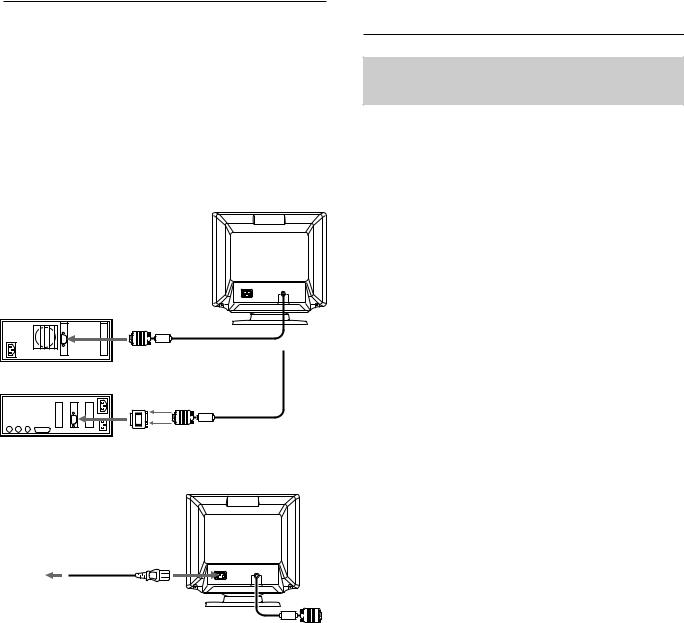
Préparation
Avant d’utiliser ce moniteur, assurez-vous que les éléments suivants figurent dans l’emballage: moniteur Multiscan 100ES/200ES (1), cordon d’alimentation (1), “Windows Monitor Information Disk”
(1) et ce mode d’emploi (1).
Ce moniteur se synchronise sur n’importe quel système IBM ou compatible équipé d’une carte VGA ou de capacités graphiques supérieures. Bien que ce moniteur se synchronise à d’autres platesformes fonctionnant sur des fréquences horizontales comprises entre 30 et 70 kHz y compris Macintosh et Power Macintosh, un adaptateur de câble est requis. Veuillez consulter votre distributeur pour des conseils relatifs à l’adaptateur répondant à vos besoins.
1re étape: L’ordinateur étant hors tension, branchez le câble de signal vidéo à la sortie vidéo.
Ordinateur IBM ou compatible
vers la sortie vidéo
Ordinateur Macintosh ou compatible
vers la sortie vidéo
adaptateur Macintosh (non fourni)
2e étape: Raccordez le cordon d’alimentation au moniteur et l’autre extrémité à la prise de courant.
Cordon d’alimentation (fourni)
à la prise de courant
3e étape: Mettez le moniteur et l’ordinateur sous tension.
4e étape: Si nécessaire, réglez les commandes utilisateur selon vos préférences personnelles.
L’installation de votre Multiscan 100ES/200ES est terminée. Nous vous souhaitons beaucoup de plaisir avec votre moniteur.
1)VGA est une marque déposée de IBM Corporation.
2)VESA est une marque déposée de l’association sans but lucratif Vidéo Electronics Standard Association.
3)Macintosh est une marque déposée de Apple Computer Inc.
4)Windows® est une marque déposée de Microsoft Corporation aux Etats-Unis d’Amérique et/ou dans d’autres pays.
Utilisation de votre moniteur
Modes par défaut et utilisateur
Le Multiscan 100ES/200ES comporte des modes par défaut pour les 8 normes industrielles les plus courantes qui le rendent véritablement “prêt à l’emploi”.
Pour les modes moins courants, la technologie numérique Multiscan du Multiscan 100ES/200ES réalise tous les réglages complexes nécessaires pour assurer une haute qualité d’image pour n’importe quelle synchronisation entre 30 et 70 kHz.
CPD-100ES/100EST et CPD-200ES/200EST
No. |
Résolution |
Fréquence |
Fréquence |
Mode |
|
(points × lignes) |
horizontal |
verticale |
graphique |
|
|
|
|
|
1 |
640 × 480 |
31,5 kHz |
60 Hz |
VGA 1) Graphic |
2 |
640 × 480 |
43,3 kHz |
85 Hz |
VESA 2) |
3 |
800 × 600 |
46,9 kHz |
75 Hz |
VESA 2) |
4 |
800 × 600 |
53,7 kHz |
85 Hz |
VESA2) |
5 |
832 × 624 |
49,7 kHz |
75 Hz |
Macintosh 3) |
|
|
|
|
16" Color |
|
|
|
|
|
6 |
1024 × 768 |
60,0 kHz |
75 Hz |
VESA 2) |
7 |
1024 × 768 |
68,7 kHz |
85 Hz |
VESA 2) |
8 |
1280 × 1024 |
64,0 kHz |
60 Hz |
VESA 2) |
Pour les clients utilisant Windows 4)95/98
Pour maximaliser le potentiel de votre moniteur, installez sur votre ordinateur le nouveau fichier d’informations modèle depuis la disquette “Windows Monitor Information Disk”.
Ce moniteur est conforme à la norme Plug & Play “VESA DDC”. Si votre PC/carte graphique est conforme à la norme DDC, sélectionnez “Plug & Play Monitor (VESA DDC)” ou la désignation de ce moniteur comme type de moniteur dans le “Control Panel” sous Windows 95/98. Si votre PC/carte graphique a des difficultés à communiquer avec ce moniteur, chargez la disquette “Windows Monitor Information Disk” et sélectionnez la désignation de ce moniteur comme type de moniteur.
Conditions de synchronisation horizontale recommandées
Largeur de synchronisation horizontale : >1,0 sec.
Largeur d’occultation horizontale : >3,6 sec. (Multiscan 100ES)/ >3,0 sec. (Multiscan 200ES).
Largeur de synchronisation verticale : < 560 sec.
Remarque
Le CPD-100ES/100EST et CPD-200ES/200EST ne convient pas pour le mode couleur Macintosh 21” .
12
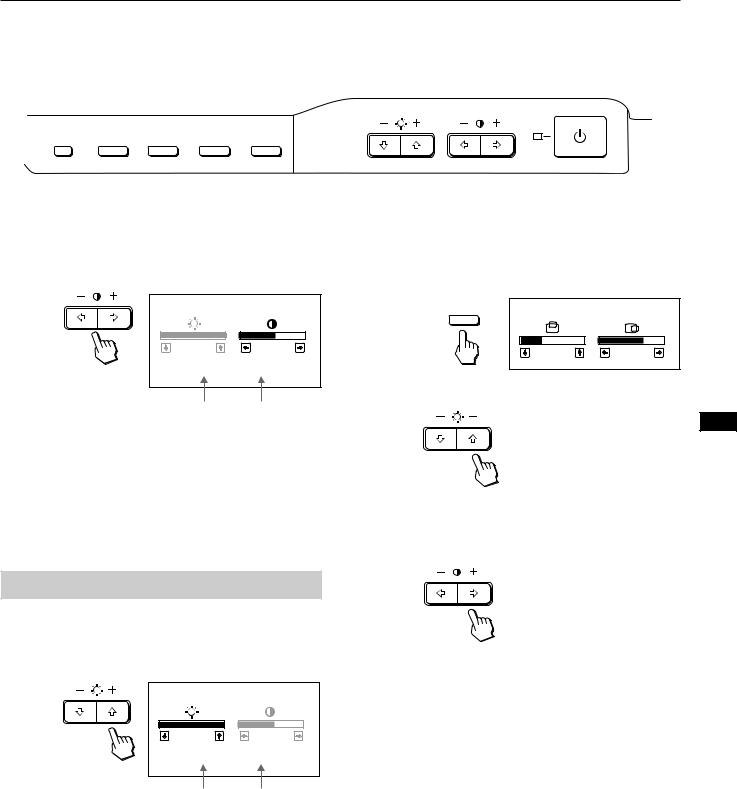
Réglages
Si l’un des signaux présélectionnés est transmis, aucun réglage n’est requis.
Vous pouvez cependant régler l’image en fonction de vos préférences en appliquant la procédure décrite ci-dessous. Vous pouvez régler tous les paramètres à l’aide des menus d’affichage OSD.
pAvant d’ajuster les différents paramètres, mettez l’appareil sous tension et transmettez le signal vidéo de l’ordinateur/ poste de travail connecté.
pLes réglages sont mémorisés automatiquement.
Panneau de commande
RESET COLOR GEOM SIZE CENTER
Réglage du contraste de l’image |
|
Réglage du centrage de l’image |
|
|
|
La valeur introduite devient le réglage commun à tous les signaux d’entrée.
1 Appuyez sur la touche >?//.
Le menu “BRIGHTNESS/CONTRAST” apparaît.
Les données de réglage deviennent le réglage individuel pour chaque signal d’entrée reçu.
1 Appuyez sur la touche CENTER. Le menu “CENTER” apparaît.
BRIGHTNESS/CONTRAST |
|
|
100 |
50 |
|
31 . 5kHz/70Hz |
2 |
|
|
|
|
Fréquence Fréquence horizontale verticale
2 Appuyez sur les touches >?//pour régler le contraste de l’image.
/. . . pour plus de contraste ?. . . pour moins de contraste
CENTER |
CENTER |
|
|
32 |
68 |
Pour le réglage du centrage vertical
Appuyez sur les touches ¨>/..
F
Le menu “BRIGHTNESS/CONTRAST” disparaît environ 3 secondes après que vous avez relâché les touches.
Pour réinitialiser le réglage, appuyez sur la touche RESET pendant que le menu est affiché.
>. . . pour remonter l’image
.. . . pour abaisser l’image
Pour le réglage du centrage horizontal
Appuyez sur les touches >?//.
Réglage de la luminosité de l’image
La valeur introduite devient le réglage commun à tous les signaux d’entrée.
1 Appuyez sur la touche ¨>/..
Le menu “BRIGHTNESS/CONTRAST” apparaît.
BRIGHTNESS/CONTRAST |
|
100 |
50 |
31. 5kHz/70Hz |
|
Fréquence |
Fréquence |
horizontale |
verticale |
2 Appuyez sur les touches ¨>/.pour régler la luminosité de l’image.
.. . . pour moins de luminosité >. . . pour plus de luminosité
Le menu “BRIGHTNESS/CONTRAST” disparaît environ 3 secondes après que vous avez relâché les touches.
Pour réinitialiser le réglage, appuyez sur la touche RESET pendant que le menu est affiché.
?. . . pour déplacer l’image vers la gauche /. . . pour déplacer l’image vers la droite
Pour désactiver le menu “CENTER”, appuyez à nouveau sur la touche CENTER.
Le menu “CENTER” disparaît automatiquement 10 secondes après que vous avez relâché les touches.
Pour réinitialiser le réglage, appuyez sur la touche RESET pendant que le menu est affiché.
Les fréquences horizontale et verticale pour chaque signal d’entrée reçu apparaissent dans le menu “BRIGHTNESS/ CONTRAST”.
13
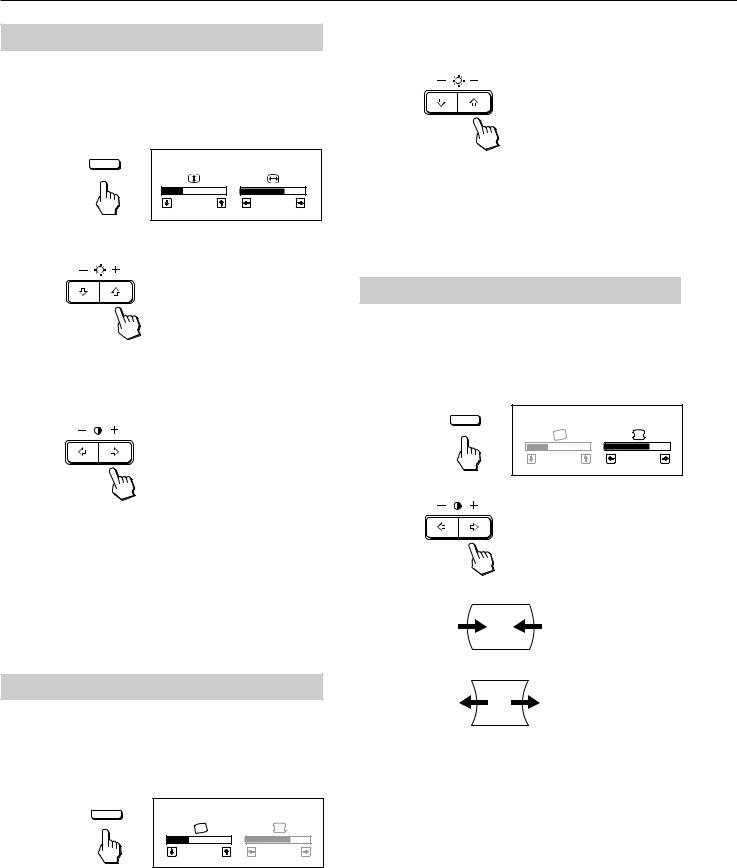
Réglages
Réglage de la taille de l’image
Les données de réglage deviennent le réglage individuel pour chaque signal d’entrée reçu.
1 Appuyez sur la touche SIZE. Le menu “SIZE” apparaît.
SIZE |
|
|
SIZE |
32 |
68 |
2 Pour le réglage de la taille verticale
Appuyez sur les touches ¨>/..
>. . . pour agrandir l’image
.. . . pour réduire la taille de l’image
Pour le réglage de la taille horizontale
Appuyez sur les touches >?//.
?. . . pour réduire la taille de l’image /. . . pour agrandir l’image
Pour désactiver le menu “SIZE”, appuyez à nouveau sur la touche SIZE.
Le menu “SIZE” disparaît automatiquement 10 secondes après que vous avez relâché les touches.
Pour réinitialiser le réglage, appuyez sur la touche RESET pendant que le menu est affiché.
Réglage de la rotation de l’image
La valeur introduite devient le réglage commun à tous les signaux d’entrée.
1 Appuyez sur la touche GEOM. Le menu “GEOMETRY” apparaît.
GEOM |
|
GEOMETRY |
|
32 |
68 |
2 Appuyez sur les touches ¨>/.pour tourner l’image. >. . . dans le sens des aiguilles d’une montre
.. . . dans le sens contraire des aiguilles d’une montre
Pour désactiver le menu “GEOMETRY”, appuyez à nouveau sur la touche GEOM.
Le menu “GEOMETRY” disparaît 10 secondes après que vous avez relâché les touches.
Pour réinitialiser le réglage, appuyez sur la touche RESET pendant que le menu est affiché.
Réglage de la distorsion en coussin
Les données de réglage deviennent le réglage individuel pour chaque signal d’entrée reçu.
1 Appuyez sur la touche GEOM. Le menu “GEOMETRY” apparaît.
GEOM |
|
GEOMETRY |
|
32 |
68 |
2 Appuyez sur les touches >?//pour tourner l’image.
?. . . pour comprimer les côtés de l’image
/. . . pour élargir les côtés de l’image
Pour désactiver le menu “GEOMETRY”, appuyez à nouveau sur la touche GEOM.
Le menu “GEOMETRY” disparaît 10 secondes après que vous avez relâché les touches.
Pour réinitialiser le réglage, appuyez sur la touche RESET pendant que le menu est affiché.
14
